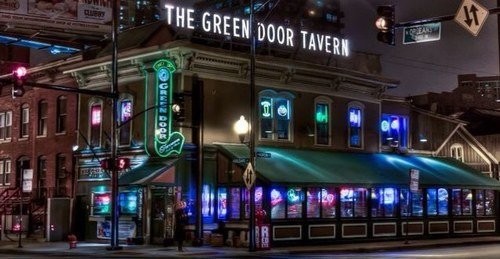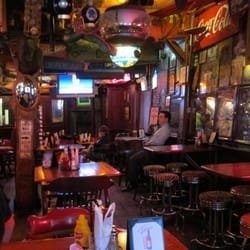Green Door Tavern
Introduction
Text-to-speech Audio
Images
Green Door Tavern at night

Green Door Tavern interior

Backstory and Context
Text-to-speech Audio
One of Chicago’s oldest bars, the Green Door Tavern has witnessed much of the city’s history. After the Great Fire of 1871, James McCole constructed a two-story wooden frame building at the corner of Orleans and Huron Streets. Shortly after the building’s completion, the Chicago City Council passed an ordinance prohibited wooden framed structures so close to the Loop making the Green Door Tavern one of the oldest wooden buildings constructed after the fire. The leaning of the building, known as racking, occurred shortly after its construction.
Between 1871 and 1921, Lawrence P. Ek rented the building from McCole and operated a grocery store on the first floor. Then in 1921, Vito Giacomo took over the building and opened a restaurant called the Heron-Orleans. In the basement of the restaurant, Vito’s sons Jack and Nello ran one of the first speakeasies in the downtown which was mostly frequented by Chicago’s gangsters. Chicago’s Dean O’Banion, leader of the North Side Gang and rivals to Al Capone’s Chicago Outfit gang, provided the speakeasy’s illegal alcohol during the 1920s.
During Prohibition, many speakeasies in Chicago featured a green door. Heron-Orleans’ green door was located on the building’s south side. The restaurant became known as the Green Door by the 1930s, and adopted the nickname as the establishment’s official title. As with most of Chicago’s former speakeasies and neighborhoods, the condition and reputation of the establishment fell considerably by the 1970s. In August 1985, George Parenti purchased the Green Door Tavern with the intent on renovating the building and returning it to its former glory. Since Parenti purchased the Green Door, the establishment has seen its return to popularity. While the Green Door Tavern operates out of the building’s main floor, in the basement is found The Drifter, an authentic 20s era speakeasy with specialty drinks and entertainment.
Cite This Entry
Martin-Gross, Kalen. "Green Door Tavern." Clio: Your Guide to History. December 3, 2018. Accessed March 29, 2025. https://theclio.com/tour/729/7/reverse
Sources
The Drifter. The Drifter. 2018. December 2, 2018. https://www.thedrifterchicago.com.
Parnell, Sean. Green Door Tavern. Chicago Bar Project. December 2, 2018. https://www.chibarproject.com/Reviews/GreenDoor/GreenDoor.htm.

